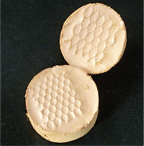Crossref Citations
This article has been cited by the following publications. This list is generated based on data provided by
Crossref.
Raeisi, H.R. Hadizadeh
Razzaghi, M.
Bahramian, A.R.
and
Kashani, M. Razzaghi
2015.
Cellulose Cork/phenolic Aerogel Nanocomposites as a Lightweight Thermal Insulator.
Procedia Materials Science,
Vol. 11,
Issue. ,
p.
527.
Tannert, René
Schwan, Marina
and
Ratke, Lorenz
2015.
Reduction of shrinkage and brittleness for resorcinol-formaldehyde aerogels by means of a pH-controlled sol–gel process.
The Journal of Supercritical Fluids,
Vol. 106,
Issue. ,
p.
57.
Hu, Peidong
Tan, Beihui
and
Long, Mingce
2016.
Advanced nanoarchitectures of carbon aerogels for multifunctional environmental applications.
Nanotechnology Reviews,
Vol. 5,
Issue. 1,
Berkefeld, André
Heyer, Markus
and
Milow, Barbara
2017.
Silica aerogel paper honeycomb composites for thermal insulations.
Journal of Sol-Gel Science and Technology,
Vol. 84,
Issue. 3,
p.
486.
Bertino, M. F.
2018.
Rapid fabrication of hybrid aerogels and 3D printed porous materials.
Journal of Sol-Gel Science and Technology,
Vol. 86,
Issue. 2,
p.
239.
White, Lauren S.
Selden, Tyler
Bertino, Massimo F.
Cartin, Charles
Angello, Joseph
Schwan, Marina
Milow, Barbara
and
Ratke, Lorenz
2018.
Fabrication of Mechanically Strong Honeycombs with Aerogel Cores.
Industrial & Engineering Chemistry Research,
Vol. 57,
Issue. 4,
p.
1197.
He, Han
Geng, Liyan
Liu, Feng
Ma, Bin
Huang, Wenxuan
Qu, Lijie
and
Xu, Baosheng
2022.
Facile preparation of a phenolic aerogel with excellent flexibility for thermal insulation.
European Polymer Journal,
Vol. 163,
Issue. ,
p.
110905.
Bertino, Massimo F.
and
Reichenauer, Gudrun
2023.
Springer Handbook of Aerogels.
p.
835.
